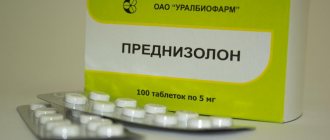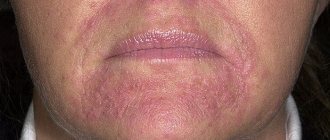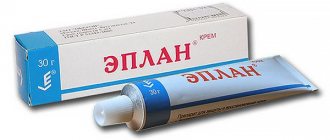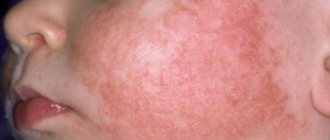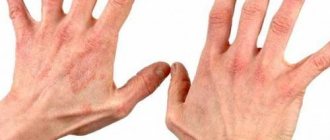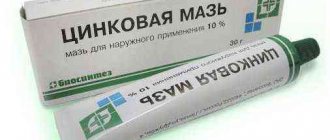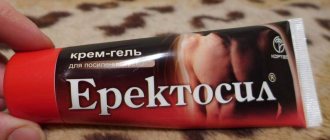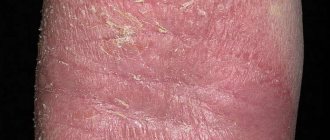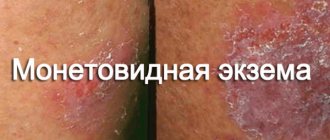Forms of application
Hypovitaminosis and dermatosis are two interrelated processes. Scientists have found that with a lack of linoleic acid, eczema develops. Peeling, dry skin, intense itching are typical manifestations of the dry form of dermatosis, which occurs against the background of reduced immunity and vitamin deficiency.
Taking vitamins alone will not get rid of the problem. An integrated approach to treatment is aimed at complete recovery. Such remedies help reduce the symptoms of eczema by activating the immune system.
Numerous studies have proven that most skin diseases arise from insufficient intake of nutrients. Low levels of saturated fatty acids and essential microelements lead to dysfunction of internal organs.
Vitamin preparations are prepared in injections, tablets, capsules, dragees, and syrups.
Effective injections for eczema are:
- Retinol is available in ampoules. Refers to fat-soluble substances. It takes part in redox reactions, the synthesis of mucopolysaccharides, proteins, and fats. Retinol is responsible for the condition of the dermis and epithelium of the mucous membranes. For eczema, it promotes rapid healing of skin defects. The drug is administered at 50,000-100,000 IU/day. Retinol acetate is injected once a day. The course lasts 5-10 days. Other forms of the drug are tablets, solution. The medicine can be applied to erosive areas of the body.
- Ascorbic acid is available in ampoules. Affects the formation of intracellular collagen and participates in redox reactions. Reduces the need for B vitamins. For eczema, it is prescribed to increase the body's protective properties. The substance inhibits the growth of bacterial agents. It is administered intramuscularly, intravenously, 1-2 ml 1 time per day.
Tablet preparations are represented by the following drugs:
- Angiovitis is a complex medicine that contains B vitamins. Take 1 tablet per day. Drink for 1 month.
- Ascovit consists of ascorbic acid. Prescribed 25-75 mg per day.
- Hexavit contains retinol acetate. Take 1 tablet 3 times a day.
- Aevit is a mixture of vitamins A and E. Prescribed 2 tablets three times a day.
Especially for children, drugs are produced in syrups. Medicines consist of vitamins and minerals (Alphabet, Vitrum, Pikovit, Supradin). The therapeutic dosage is selected according to the age of the child.
Types of injections by action
Mild forms of eczema are treated with tablets and local medications, moderate and complicated forms are treated with injections. Let's look at what injections are used for eczema.
Antihistamine therapy
Antihistamine drugs block components that cause allergies and increased immune reactivity, reducing the severity of inflammation. With the help of antihistamine injections you can achieve the following results:
- reduce the severity of skin itching;
- create a sedative effect;
- eliminate swelling;
- prevent the risk of bronchospasms;
- improve the condition of the epidermis.
In case of advanced eczema and there are indications for antihistamine therapy, injections of Diphenhydramine, Suprastin, Promethazine and Diphenhydramine are used.
Antibiotics
Prescribed for advanced forms of skin pathology complicated by bacterial infection. Antibacterial drugs quickly inhibit the vital activity of microorganisms, preventing their reproduction and spread, which makes it possible to successfully stop the inflammatory process.
Injection of antibiotics for eczema is indicated in the following cases:
- extensive lesions in the arms and legs;
- purulent complications, risk of sepsis;
- bacterial plaque in eczema lesions;
- weak immune system.
What vitamins should you take?
Lack of vitamins negatively affects the condition of internal systems and organs. According to statistics, 75% of nutrients that come from food are not absorbed. Poor quality, unhealthy food does not replenish the supply of nutrients. To help patients, dermatologists advise taking vitamins in several courses. Medicines prevent colds and skin diseases. A strong immune system is difficult to overcome by bacterial and viral agents.
Omega 3
Omega 3 for eczema replenishes the supply of polyunsaturated fatty acids, which the body lacks due to the typical lesions of this disease. Omega 3 strengthens the immune system, improves the functioning of the nervous and cardiovascular systems, and improves brain performance. Polyunsaturated fatty acids have an anti-inflammatory effect.
The pharmacy sells Omega 3 in different flavors. Take 1 capsule three times a day with meals. The medicine exhibits pronounced activity in combination with retinol and calciferol.
To replenish the reserves of polyunsaturated fatty acids, it is recommended to eat fish, algae, fish, and goose fat.
Group B
- Cyanocobalamin vitamin B12 is prescribed for skin diseases of the hands and feet. Reduce the intensity of itching, burning, and pain. The medicine combats peeling and excessive dryness of the skin.
- Pyridoxine (B6) is included in ointments for various types of dermatitis. The substance relieves itching and swelling.
- Thiamine (B1) regulates the activity of the nervous system, reduces pain in eczema and psoriasis. The substance improves brain function, an indispensable element during pregnancy and breastfeeding.
- With this disease, the patient is irritable and depressed. There is a bad mood due to severe itching. The effect of Magnesium B6 in eczema has a positive effect on the nervous system and has a complex effect on the patient’s condition. It calms down and scratches itchy areas of the body less. Another drug, magnesium sulfate, has a similar name. Has anticonvulsant, antiarrhythmic, antihypertensive effects. During treatment, it is important not to confuse the names of medications.
Oats, beets, cabbage, bran and other foods contain a huge amount of B vitamins.
Vitamin D
Eczema can occur due to a lack of calciferod. The latter is responsible for the proliferation and regeneration of keratinocytes and hair follicles. Element deficiency is manifested by dry skin, peeling, and ulcerative defects. Long-term use of calciferol leads to a reduction in inflammation on the skin. Under the influence of the substance, a wound healing effect is manifested.
Californian scientists have proven another benefit of vitamin D for eczema. The cathelicidin protein is responsible for the condition of the dermis and prevents microorganisms from entering the skin pores. During a scientific study, patients with eczema were given calciferol. Under its influence, skin defects disappeared after 20 days due to an increase in the level of cathelicidin.
Other
Retinol affects the formation of hyaluronic acid and restores the integrity of the integument. Molecules of a substance have the following properties:
- Penetrate into the deep layers of the skin and affect reparative processes.
- Increases the resistance of the dermis to infectious agents.
- Normalize nutrient metabolism.
For the therapeutic agent to work, it is recommended to take it together with vegetable and animal fats. The medicine is sold in the form of capsules that can be opened and applied to the skin.
Ascorbic acid strengthens the walls of blood vessels and inhibits the formation of serous fluid in eczematous papules. The swelling disappears. Able to influence the production of glucocorticosteroids, which relieve inflammatory processes.

Dermatotropic products LLC
Good afternoon
Today I want to talk about the procedure for intravenous and intramuscular administration of calcium gluconate solution. In total, I took the drug three times in courses.
Calcium gluconate-Vial LLC “Alvis” solution 10 ml
true eczema for several years now . Initially, the disease was localized only on the hands, but, to my great regret, it recently spread to the face.
Of course, there are periods of remission when my skin is almost clear, but as soon as I get nervous, wash something without gloves, or deviate too much from my diet, an exacerbation will begin .
One of the most effective means of eliminating the crisis is injections of calcium gluconate, which are often prescribed in such cases.
Calcium gluconate-Vial LLC “Alvis” solution 10 ml
The drug is produced by many pharmaceutical companies, but the active ingredient is always the same:
calcium gluconate monohydrate 100 mg/ml.
The composition of excipients may differ from one manufacturer to another, but I don’t see any difference and when I go to the pharmacy I always simply ask for “calcium gluconate .
Ampoules of calcium gluconate for intravenous and intramuscular administration
Calcium gluconate-Vial LLC “Alvis” solution 10 ml
The last time I purchased ampoules from Alvis LLC, calcium gluconate - Vial , which will be discussed in this article.
Full name: Calcium gluconate – Vial.
Calcium gluconate-Vial LLC “Alvis” solution 10 ml
Manufacturer: China, by order of Alvis LLC, Moscow. The fact that I only saw the Chinese drug at home and it bothered me a little.
Release form: 10 ampoules of 10 ml.
Calcium gluconate in ampoules is often sold individually in pharmacies. I purchased 1/2 pack, that is, 5 ampoules. Probably because half of the package was sold, the pharmacist put a cross on the front and back of the cardboard box with a pen.
Calcium gluconate-Vial LLC “Alvis” solution 10 ml
A regular white cardboard box with a purple stripe on the side, inside which there are instructions and 10 ampoules on a plastic backing.
Calcium gluconate-Vial LLC “Alvis” solution 10 ml
Compound:
For 1 ml.
Active ingredient: calcium gluconate monohydrate 100 mg/ml.
Excipients: lactic acid 5 mg, calcium hydroxide 0.5 mg, water for injection qs up to 1.0 ml.
Pharmacological action and indications for use:
Calcium gluconate-Vial LLC “Alvis” solution 10 ml
Improves muscle contraction in muscular dystrophy, myasthenia gravis, and reduces vascular permeability. When administered intravenously, calcium causes stimulation of the sympathetic nervous system and increased secretion of adrenaline by the adrenal glands; has a moderate diuretic effect.
Hypocalcemia of various origins, hypoparathyroidism, parenchymal hepatitis, toxic liver damage, nephritis, eclampsia, hyperkalemic form of paroxysmal myoplegia, inflammatory and exudative processes, skin diseases.
As an additional remedy in the treatment of allergic diseases and drug allergies. As an additional hemostatic agent for pulmonary, gastrointestinal, nasal, and uterine bleeding.
As an antidote for poisoning with magnesium salts, oxalic acid and its soluble salts.
The range of application of the drug is wide. Improvement in the patient's condition during exacerbation of skin diseases and allergies occurs due to the following:
With a sufficient amount of calcium in the human body, the permeability of the walls of blood vessels decreases, as a result of which an obstacle is formed to the penetration of allergens into the circulatory system. This means that as calcium concentration increases, the likelihood of an acute immune reaction decreases.
For allergies, calcium gluconate is often prescribed, which helps to increase not only the calcium content, but also a substance that affects the condition of connective tissue (gluconate), which significantly speeds up the healing process. As a rule, calcium gluconate is prescribed in combination with antihistamines.
Contraindications:
Hypercalcemia, severe hypercalciuria, severe renal failure, susceptibility to thrombosis, hypersensitivity to calcium gluconate.
EXPERIENCE OF USE.
Calcium gluconate-Vial LLC “Alvis” solution 10 ml
IM, IV slowly (over 2-3 minutes) or drip, for adults – 5-10 ml of 10% solution daily, every other day or every 2 days (depending on the nature of the disease and the patient’s condition).
Children - IV slowly (over 2-3 minutes) or drip, depending on age, from 1 to 5 ml of a 10% solution every 2-3 days.
Course No. 1. Intramuscularly.
The first time the dermatologist prescribed me a solution of calcium gluconate intramuscularly, 5 ml, 5 times in July 2020 . At that time, I had already had a terrible exacerbation of eczema on my hands for a week: bacteria got into the wounds from blisters and cracks and suppuration formed. The photo shows the hand immediately after the pus has come out.
True eczema on the hands.
Probably, if I had started taking the drug from the first day, I would have been able to avoid a lot of suffering. But since the exacerbation began on Thursday evening, there were no numbers at the hospital on Friday, and in general it was possible to get an appointment only on Wednesday, when the acute stage gave way to the subacute stage. To be honest, I just got tired of these 5 times. I don’t remember a more painful injection in the buttocks. Firstly, 5 ml. - this is a lot for intramuscular injection, plus the diameter of the needle is large. I left the hospital limping. Sorry for the details, but the half-buttock after the injection of the drug hurts terribly for several days, it is impossible to lie on your back and on the side where the injection was given, and the next day they put an injection in the other buttock and both already hurt. Later, other doctors were very surprised why I was prescribed calcium gluconate intramuscularly.
- The therapeutic effect of intramuscular administration of the drug is insignificant; intravenous administration is much more effective.
- Intravenous administration of the drug, if the injection is done by an experienced nurse, is practically painless: you can immediately forget about the injection after leaving the treatment room.
Result. I believe that course had virtually no effect on my recovery. Firstly, I started taking calcium gluconate at a time when the exacerbation was already subsiding. Secondly, I used Akriderm Genta hormonal ointment, took an antihistamine, treated the wounds with fucorcin and followed a diet.
Conclusion: if you have been prescribed calcium gluconate intramuscularly, ask the doctor several times: WHY? After all, the injections are very painful, and the effectiveness of such administration of the medicine is low.
Course No. 2. Intravenously.
I became acquainted with the procedure of so-called “hot injections”, intravenous administration of calcium gluconate at the end of September 2018. At that time, I had a subacute stage of eczema on my hands and a small spot appeared on my forehead. I gave 5 injections of 10 ml each. I felt better, but it was my own fault that the effect was short-lived: I didn’t follow the diet.
I didn’t take BEFORE and AFTER photos then. I will tell you more about the procedure, sensations and results below.
Course No. 3. Intravenously.
In December 2020, I felt great: my hands were healed, the night itching disappeared, and there was practically no trace of eczema on my forehead. I did not take antihistamines or use hormonal ointment.
I took a course of Polysorb , started taking the probiotic Narine-Forte, followed a diet, and sometimes allowed myself to eat a small amount of prohibited foods. I even started to think that clear skin would stay with me for a long time. The New Year holidays are here...
I started eating everything, and one fine Monday morning I woke up and saw this in the mirror:
First day. True eczema on the face. Hot injections, intravenous administration of calcium gluconate for allergies.
This is the first time I’m posting my entire face on this site and in this form...
I had a huge spot on my forehead, on my cheeks and a small one above my lip, and the skin on my eyelids also became red, swollen, and began to peel. The affected areas were very itchy and wet. Hands remained relatively clean.
I went to the skin and venereal disease clinic, and they only gave me a number the next Monday, a week later.
How to hold out until the reception? I won’t use hormonal ointment without a doctor’s prescription, so I decided to make a move and went to the city clinic to get a number to see a therapist with the expectation that the calcium gluconate for me.
My calculation was correct, on Tuesday evening I saw the doctor on duty, who, having approved my plan of action, gave me a referral for hot injections, 5 pieces of 10 ml each . I had my first injection on Wednesday, that day I looked like this:
True eczema on the face. 3rd day from the onset of exacerbation.
Before visiting the dermatologist, I was treated as follows:
- I wiped my face with chamomile infusion and did not wash my face.
- Three or four times a day I applied special Emolium cream .
- Zinc ointment for drying the affected areas. 2 times a day.
- Saw Polysorb. 1 tablespoon in half a glass of water 20 minutes before meals.
- Narine-forte, probiotic, 2 tablespoons per day.
- Take Cetrin 1 tablet at night.
- Hypoallergenic diet. Maximum strict. In the morning, a little cottage cheese without sugar, in the afternoon, rice or buckwheat and a small piece of boiled beef, a steamed peeled green apple. Hypoallergenic diet. Grocery list.
- I drank about 1.5-2 liters of boiled water. in a day.
Hot injections have been added since Wednesday. I felt improvement by Friday, that is, after the third injection. Skin condition on Friday and Saturday mornings.
Fifth day. True eczema on the face. Hot injections, intravenous administration of calcium gluconate for allergies.
Sixth day. True eczema on the face. Hot injections, intravenous administration of calcium gluconate for allergies.
After a visit to the dermatologist, hormonal creams were added to my treatment regimen, and zinc ointment was removed . The course of intravenous administration of calcium gluconate was increased from 5 to 10 procedures. The doctor asked me several more times whether I was tolerating these injections well. And I didn’t even know that someone could not tolerate them. I did not experience any side effects.
Possible: nausea, vomiting, diarrhea, bradycardia; with intramuscular injection – necrosis.
Skin condition on the 10th day:
Tenth day. True eczema on the face. Hot injections, intravenous administration of calcium gluconate for allergies.
On the 13th:
Thirteenth day. True eczema on the face. Hot injections, intravenous administration of calcium gluconate for allergies.
Recommendations for preparation and sensations during the procedure.
- Before the injection, you must eat a large meal. Your doctor should give you this recommendation when prescribing the medicine. Don't neglect this rule! I always came to my injection well-fed. The nurse also checked before introducing me whether I had eaten.
- The solution should be at body temperature. Do not store ampoules in the refrigerator. If you administer the drug in winter, it is better to carry the ampoule to the hospital not in your bag, but in your pocket, under your clothes. While you sit in line and wait, hold the medicine in your hand and warm the medicine. Hot injections, intravenous administration of calcium gluconate for eczema
- If you are impressionable, then it is better not to look at the process of administering the drug itself. Turn away, close your eyes. Some people feel uneasy at the sight of a 10 ml syringe, a needle, and the blood that gets into the syringe.
- The process itself does not take much time. 3 minutes. First, gradually introduce half, then stop. The first wave of heat should pass through the body. It originates somewhere around the cheeks, then surrounds the mouth in a ring and rises up to the very top of the head. In parallel, the second flow goes into the stomach and descends into the pelvis. I love this feeling of spreading warmth. After the waves have passed, you need to tell the health care worker, after which the second half of the drug will be administered. You shouldn’t immediately jump up and run out of the treatment room; you need to wait until the warmth passes through your body again.
- Do not go outside immediately after the hot injection procedure. Sit in the corridor for 10-15 minutes. Keep your arm bent; if you immediately straighten it, a bruise may form.
- If you follow all the recommendations and the drug is administered to you by a professional, then the injection site will not hurt and there will be no trace left. Do you see 3 injection marks here? Hot injections, intravenous administration of calcium gluconate
Of course, I recommend, if your doctor has prescribed it for you, to take a course of calcium gluconate. Hot injections into a vein are more effective; intramuscular injection of the drug is less effective and more painful.
Source: https://irecommend.ru/content/inektsii-glyukonata-kaltsiya-moe-spasenie-pri-obostreniyakh-istinnoi-ekzemy-na-rukakh-i-lits
Rules of application
- You cannot independently increase the dosage and frequency of medications. The maximum result in improving your health will be obtained if you follow all points of the instructions for the drug.
- The course of treatment is long. For a positive effect, you must take the medicine for a month or more. It is not recommended to take breaks between therapy. Strict adherence to medical recommendations will help to recover from pathological conditions and increase the body's defenses.
- When treating eczema with several vitamins, it is necessary to take into account their compatibility with each other, minerals, and drugs for dermatosis. B12 does not work with other representatives of group B. B1 and B6 in injections, when administered simultaneously, compete and do not show an improving effect.
- During treatment, it is strictly forbidden to drink alcoholic beverages or smoke. They cause irreparable harm to the body, destroy the immune system, and interfere with the absorption of nutrients.
- It is better not to take some complexes at once. The body does not absorb large amounts of such substances. Experts recommend dividing the daily dosage into 3 doses to achieve maximum effectiveness.
- During treatment of the disease, it is advisable to pay attention to the diet. Carbonated drinks and fatty foods negatively affect the condition of the skin and internal organs. Vegetables and fruits, raw or steamed, will supplement your supply of micronutrients.
Injections (shots) for eczema
Drug treatment of eczema is based not only on the use of drugs intended for local therapy - ointments, creams and antiseptic solutions. Injections are also prescribed to stop the progression of skin pathology in difficult clinical cases. We invite you to find out what injections for eczema exist and how effective they are.
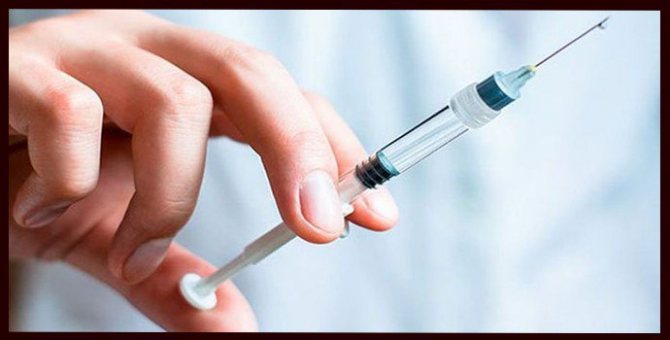
Contraindications and likelihood of side effects
Side effects from the drugs are rare. If a rash, redness, or swelling occurs, you must stop taking the medication and consult a physician.
Contraindications to treatment include:
- Personal intolerance to the components of the drug leads to allergization of the body. People with a history of allergies need to carefully select the drug.
- In the presence of decompensated renal diseases, calciferol and retinol are prescribed with caution.
- Tocopherol should not be used in people with a high risk of thrombosis, atherosclerosis, or myocardial infarction.
- Gallstone disease, chronic pancreatitis, glaucoma are relative contraindications for taking retinol.
Vitamin complexes help improve weakened immunity due to eczema. If the patient has contraindications to treatment with drugs, therapy is carried out with symptomatic drugs.
Eczema is a disease that affects people with reduced immunity.
Taking vitamins for dermatitis helps strengthen the body's protective properties and speedy recovery. The article has been verified by the editors
Overdose
The most common side effect when taking vitamins is an overdose of individual microelements. In this case, a person experiences the following symptoms:
- nausea;
- stomach ache;
- drowsiness;
- irritability;
- weakness;
- rashes on the body;
- convulsions.
Clinical manifestations of an overdose of vitamins may differ depending on the individual characteristics of a person and the microelement that is in excess in his body. For example, a high concentration of ascorbic acid can cause bleeding in the gastrointestinal tract, and B vitamins can cause problems with the liver. Therefore, you should be careful when taking any microelements, do not self-prescribe and strictly follow your doctor’s recommendations.
Eczema is a chronic skin disease of people with low immunity. Vitamin therapy during exacerbation of pathology helps improve the body's defenses and accelerate the onset of remission.
source
